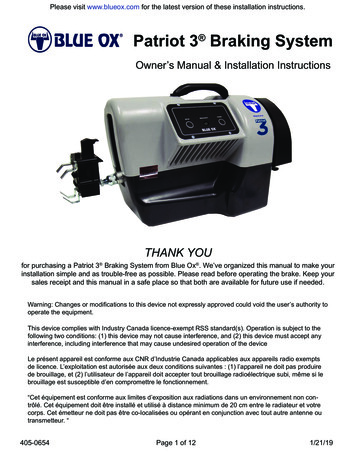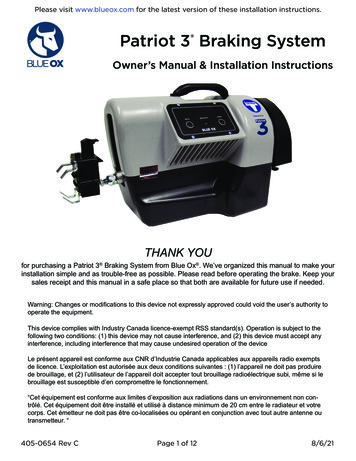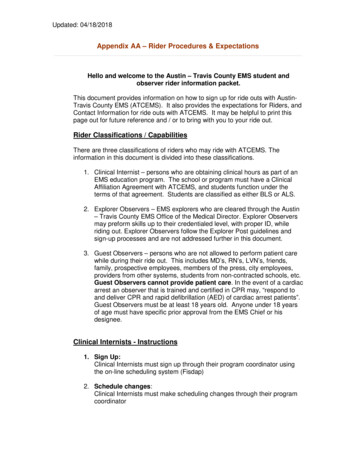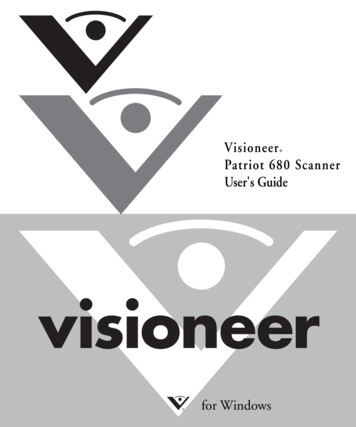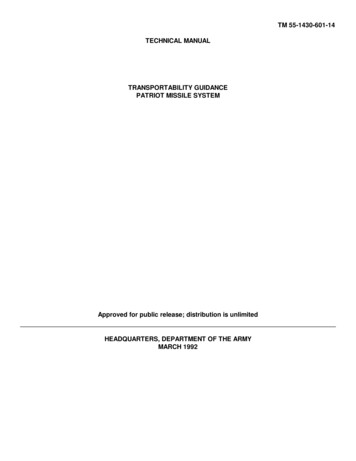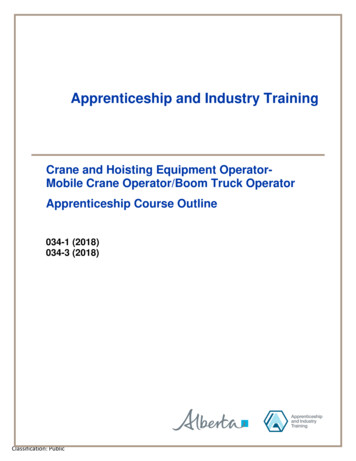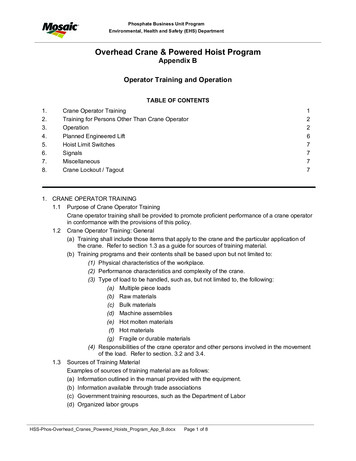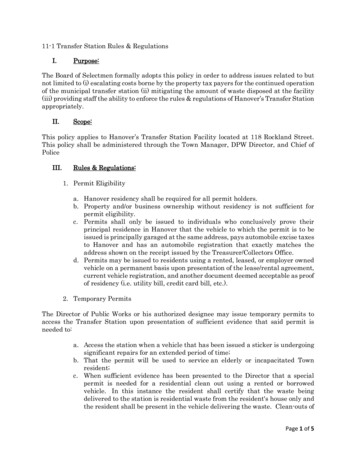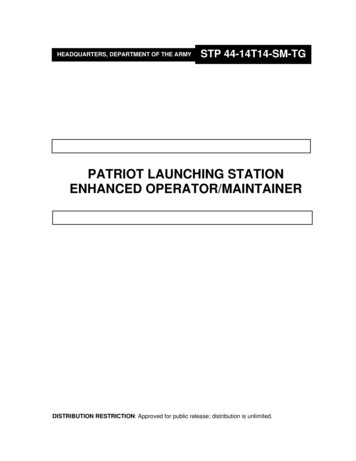
Transcription
HEADQUARTERS, DEPARTMENT OF THE ARMYSTP 44-14T14-SM-TGPATRIOT LAUNCHING STATIONENHANCED OPERATOR/MAINTAINERDISTRIBUTION RESTRICTION: Approved for public release; distribution is unlimited.
*STP 44-14T14-SM-TGSOLDIER TRAININGPUBLICATIONNo. 44-14T14-SM-TGHEADQUARTERSDEPARTMENT OF THE ARMYWashington, DC, 15 March 2002SOLDIER'S MANUAL and TRAINER'S GUIDEMOS 14TPatriot Launching Station Enhanced Operator/MaintainerSkill Levels 1, 2, 3 and 4TABLE OF CONTENTSPAGEPREFACE.ivCHAPTER 1. INTRODUCTION . 1-1CHAPTER 2. TRAINER’S GUIDE. 2-1CHAPTER 3. MOS/SKILL LEVEL TASKS . 3-1Skill Level 1Subject Area 1: Launching Station MO&E and PMCS441-082-1100 Perform Launching Station (LS) Emplacement. 3-1441-082-1102 Perform Launching Station (LS) March Order. 3-3441-082-1104 Perform Operator Preventive Maintenance Checks and Services(PMCS)/Corrective Maintenance on Guided Missile Canister (GMC) . 3-5441-082-1105 Perform Operator/Organizational Preventive Maintenance Checks andServices (PMCS) on the Launching Station (LS). 3-7441-084-1116 Prepare DA Form 2404 or DA Form 5988-E. 3-9441-084-1500 Operate Patriot Automated Logistics System (PALS).3-11441-084-1501 Perform Preventive Maintenance Checks and Services (PMCS) on PatriotAutomated Logistics System (PALS).3-12Subject Area 2: Perform Operator/Organizational Maintenance on LS441-082-1000 Perform Operator/Organizational Maintenance on the Launching Station(LS) Ac/Dc Distribution System.3-13441-082-1001 Perform Operator/Organizational Maintenance on the Launching Station(LS) Data Link Terminal Module (DLTM).3-15441-082-1002 Perform Operator/Organizational Maintenance on the Launching Station(LS) Launcher Electronics Module (LEM).3-17441-082-1003 Perform Operator/Organizational Maintenance on the Launching Station(LS) Launcher Mechanics .3-19441-082-1004 Perform Operator/Organizational Maintenance on the Launching Station(LS) Launcher Missile Round Distributor (LMRD) .3-21441-082-1005 Perform Operator/Organizational Maintenance on the Launching Station(LS) Missile Round Cable Test Set (MRCTS) .3-23DISTRIBUTION RESTRICTION: Approved for public release; distribution is unlimited.*This publication supersedes STP 44-14T1-SM, 24 Jul 97, and STP 44-14T24-SM-TG, 19 Nov 97.i
STP 44-14T14-SM-TG441-082-1006 Perform Operator/Organizational Maintenance on the Launching StationTest Set (LSTS) .3-24441-082-1007 Perform Operator/Organizational Maintenance on the Launching Station(LS) Enhanced Launcher Electronics System (ELES) .3-25441-082-1110 Perform Operator/Organizational Maintenance on the Launching StationDiagnostic Unit (LSDU).3-27441-084-1422 Perform Preventive Maintenance Checks and Services (PMCS) on the Test,Measurement, and Diagnostic Equipment (TMDE) .3-29Subject Area 3: Road March and Vehicle Operations441-084-1108 Operate the HEMTT Series Vehicle .3-30441-084-1574 Initialize the Remote Launch at the Communications Relay Group (CRG) .3-32441-084-1575 Relinquish the Remote Launch at the Communications Relay Group (CRG). .3-33Subject Area 4: Missile Reload441-082-1106 Load a Guided Missile Canister (GMC) onto the Guided Missile Transporter(GMT).3-35441-082-1107 Load a Guided Missile Canister (GMC) onto the Launching Station (LS).3-36441-082-1108 Remove a Guided Missile Canister (GMC) from the Launching Station (LS) .3-38441-082-1109 Remove a Guided Missile Canister (GMC) from the Guided MissileTransporter (GMT) .3-40441-084-1111 Operate Crane Mounted on a 10-Ton Vehicle .3-41441-084-1112 Signal Crane Operator Using Standard Arm-and-Hand Signals .3-42Subject Area 5: Communications Equipment 587-2075Perform Operator's Troubleshooting on SINCGARS .3-43Operate SINCGARS Single Channel (SC).3-44Operate SINCGARS Frequency Hopping (FH) (Net Members).3-45Operate SINCGARS Data Devices .3-46Subject Area 6: Surviving to Operate (STO) 084-1513Operate the M8A1 Alarm System.3-48Locate Mines With an AN/PSS-12 Mine Detector.3-54Perform Denial and Destruction (D2) of the Patriot System.3-57Perform Battlefield Damage Assessment and Repair (BDAR) of PatriotEquipment .3-60Subject Area 7: Patriot Support Maint Equip, MO&E, and 14441-084-1419Emplace the Battalion/Battery Maintenance Center (BMC) .3-62Emplace the 15-KW Generator Set.3-63March Order the Battalion/Battery Maintenance Center (BMC).3-64March Order the 15-KW Generator Set.3-65Perform Operator Preventive Maintenance Checks and Services (PMCS) onthe Patriot Support and Maintenance Equipment (PSME) .3-66Skill Level 2Subject Area 8: Supervising Launching Station Operations441-084-2000 Supervise Battlefield Damage Assessment and Repair of Patriot Equipment.3-67441-082-2054 Supervise Launching Station (LS) Emplacement.3-68441-082-2055 Supervise Launching Station (LS) March Order .3-70441-082-2056 Supervise Preventive Maintenance Checks and Services (PMCS)/CorrectiveMaintenance on the Guided Missile Canister (GMC) .3-71ii
*STP 44-14T14-SM-TGSubject Area 9: Supervising Patriot Support Maint Equip, MO&E, and 06Supervise Emplacement of the System Maintenance Section Equipment .3-72Supervise March Order of the System Maintenance Section Equipment .3-73Supervise Patriot System Operator/Organizational Maintenance.3-74Supervise Maintenance of the Test, Measurement, and DiagnosticEquipment (TMDE) .3-75Skill Level 3Subject Area 10: Supervising Launching Section Operations441-082-3028 Supervise Missile Reload .3-77441-082-3029 Supervise Operator/Organizational Preventive Maintenance Checks andServices (PMCS) on Launching Section Equipment .3-79441-084-3026 Supervise Road March Procedures .3-81Skill Level 4Subject Area 11: Monitoring Launching Section Operations441-082-4027 Monitor Launcher Platoon Emplacement .3-82441-082-4028 Monitor Launcher Platoon March Order .3-84441-082-4032 Monitor Preventive Maintenance Checks and Services (PMCS) on LauncherPlatoon Equipment.3-86Subject Area 12: Monitoring STO Procedures441-084-4027 Supervise Sustained Operations.3-88441-084-4028 Monitor Denial and Destruction (D2) of Patriot Equipment .3-90441-084-4029 Supervise Perimeter Defense .3-92Subject Area 13: Monitoring Patriot Support Maint Equip, MO&E, and PMCS441-082-4020 Monitor Emplacement of Maintenance Platoon Equipment .3-94441-082-4021 Monitor March Order of Maintenance Platoon Equipment .3-95441-084-4022 Monitor Fault Isolation and Operator/Organizational MaintenanceProcedures in the Patriot Fire Unit (FU) .3-96441-084-4023 Monitor Preventive Maintenance Checks and Services (PMCS) on thePatriot System.3-98441-084-4025 Monitor Road March Procedures .3-99Appendix ADA Form 5164-R (Hands On Evaluation) Instructionsto the Trainer.A-1Appendix BDA Form 5165-R (Field Expedient Squad Book)Instructions to the Trainer .B-1Glossary .Glossary-1References. References-1iii
STP 44-14T14-SM-TGPREFACEThis publication is for soldiers holding MOS 14T (Skill Levels 1 through 4) and their trainers or first-linesupervisors. It contains standardized training objectives, in the form of task summaries, which trainersand supervisors should use to train and evaluate soldiers on critical tasks, which support unit missionsduring wartime. Soldiers holding MOS 14T must have access to this publication. It should be available inthe soldier's work area, unit learning center, and unit libraries. Trainers and first-line supervisors willactively plan for soldiers to have access to this publication; however, it is not necessary for each soldier tohave an individual copy.The proponent for this publication is HQ, TRADOC. This manual applies to both Active and ReserveComponent soldiers. We encourage you, the users, to recommend changes and submit comments toimprove this publication. You should use DA Form 2028. Key your comments to the specific page,paragraph, and line of text in which you recommend the change. Provide reasons for each comment toensure understanding and complete evaluation. Send the completed form to Commandant, United StatesArmy Air Defense Artillery School, ATTN: ATSA-DT-WF, Fort Bliss, Texas 79916-3802.Unless this publication states otherwise, the masculine nouns and pronouns do not refer exclusively tomen.iv
STP 44-14T14-SM-TGCHAPTER 1INTRODUCTIONGENERALThis manual identifies the individual MOS training requirements for soldiers in MOS 14T. Commanders,trainers, and soldiers should use it to plan, conduct, and evaluate individual training in units. This manualis the primary MOS reference to support the self-development and training of every soldier.Use this manual with the soldier's manuals of common tasks (STPs 21-1-SMCT and 21-24-SMCT),ARTEPs, and FM 25-101 to establish effective training plans and programs, which integrate soldier,leader, and collective tasks.SOLDIER'S RESPONSIBILITIESEach soldier is responsible for performing individual tasks, which the commander identifies, based on theunit's METL. The soldier must perform the task to the standards listed in the SM. If a soldier has aquestion about how to do a task or which tasks in this manual he must perform, it is the soldier'sresponsibility to ask the first-line supervisor for clarification. The first-line supervisor knows how toperform each task or can direct the soldier to the appropriate training materials.NCO SELF-DEVELOPMENT AND THE SOLDIER'S MANUALSelf-development is one of the key components of the leader development program. It is a planned,progressive, and sequential program followed by leaders to enhance and sustain their militarycompetencies. It consists of individual study, research, professional reading, practice, and selfassessment. Under the self-development concept, the NCO, as an Army professional, has theresponsibility to remain current in all phases of the MOS. The SM is the primary source for theNCO to use in maintaining MOS proficiency.Another important resource for NCO self-development is the Army Correspondence Course Program(ACCP). Refer to DA Pamphlet 350-59 for information on enrolling in this program and for the list ofcourses, or write to: Army Institute for Professional Development, US Army Training Support Center,ATTN: ATIC-IPS, Newport News, VA 23628.Unit learning centers are a valuable resource for planning out self-development programs. They can helpaccess enlisted career maps, training support products, and extension training materials.FEEDBACKAt the completion of each evaluation, score the soldier GO if he passes all performance measures. Scorethe soldier NO-GO if he fails any performance measures. Conduct an AAR with the soldier. If the soldierfailed any performance measure, explain what he did wrong and how to do it correctly. If performancewarrants, suggest a remedial training plan to correct the deficiency.TRAINING SUPPORTThis manual includes the following appendixes and information, which provide additional trainingsupport information: Appendix A, DA Form 5164-R (Hands-On Evaluation) Instructions to the Trainer. The trainermay use this form to keep a record of the performance measures a soldier passes or fails.This form is applicable to all tasks in this SM. This appendix contains a sample of a completedDA Form 5164-R.1-1
STP 44-14T14-SM-TG Appendix B, DA Form 5165-R (Field Expedient Squad Book) Instructions to the Trainer. Thisappendix provides an overprinted copy of DA Form 5165-R for the tasks in this MOS. TheNCO trainer can use this form to set up the leader book described in FM 25-101, Appendix B.The use of this form may help preclude writing the soldier tasks associated with the unit'smission-essential task list, and can become a part of the leader book. Glossary. The glossary, which follows the last appendix, combines acronyms, abbreviations,definitions, and letter symbols into a single comprehensive list. 1-2References. This section contains a list of references, which support training of all tasks in thisSM.
STP 44-14T14-SM-TGCHAPTER 2TRAINER’S GUIDEThe TG identifies the essential components of a unit training plan for individual training. Units havedifferent training needs and requirements based on differences in environment, location, equipment,dispersion, and similar factors. Therefore, the TG is intended as a guide for conducting unit training andnot as a rigid standard.The TG provides information necessary for planning training requirements for the MOS. The TG— Identifies subject areas in which soldiers must be trained. Identifies the critical tasks for each subject area. Specifies where soldiers are initially trained on each task. Recommends how often to train each task to sustain proficiency. Recommends a strategy for cross-training soldiers. Recommends a strategy for training soldiers to perform higher-level tasks.BATTLE-FOCUSED TRAININGAs described in FMs 25-100 and 25-101, the commander must first define the METL as the basis for unittraining. Unit leaders use the METL to identify the collective, leader, and soldier tasks which supportaccomplishment of the METL. Unit leaders then assess the status of training and lay out the trainingobjectives and the plan for accomplishing needed training. Once the long- and short-range plans areprepared, leaders then execute and evaluate training. Finally, the unit's training preparedness isreassessed and the training management cycle begins again. This process ensures that the unit hasidentified what is important for the wartime mission, that the training focus is applied to the necessarytraining, and that training meets established objectives and standards.RELATIONSHIP OF SOLDIER TRAINING PUBLICATIONS TO BATTLE-FOCUSED TRAININGThe two key components of enlisted STPs are the trainer's guide and soldier's manual. The TG and SMgive leaders important information to help in the battle-focused training process. The TG relates soldierand leader tasks in the MOS and skill level to duty positions and equipment. It provides information onwhere the task is trained, how often training should occur to sustain proficiency, and who in the unitshould be trained. As leaders go through the assessment and planning stages, they should use the TGas an important tool in identifying what needs to be trained. The execution and evaluation of soldier andleader training should rely on the Armywide training objectives and standards in the SM task summaries.The task summaries ensure that soldiers in any unit or location have the same definition of taskperformance and that trainers evaluate the soldiers to the same standard.Figure 2-1 shows the relationship between battle-focused training and the use of the TG and SM. Theleft-hand side of the diagram shows the process of soldier training taken from FM 25-101, while the rightside of the diagram shows how the STP supports each step of this process.2-1
STP 44-14T14-SM-TGBATTLE-FOCUS PROCESSSELECTS SUPPORTINGSOLDIER TASKSCONDUCTS TRAININGASSESSMENTDETERMINES TRAININGOBJECTIVESDETERMINES STRATEGYAND PLANS FOR TRAININGCONDUCTS PRE-EXECUTIONCHECKSSTP SUPPORT PROCESSUSES TG TO RELATETASKS TO METLUSES TG TO DEFINE WHATSOLDIER TASKS TO ASSESSUSES TG TO SETOBJECTIVESUSES TG TO RELATESOLDIER TASKS TO STRATEGYUSES SM TO DETERMINETRAINING PREPARATIONEXECUTES TRAININGAND CONDUCTSAFTER ACTION REVIEWUSES SM TASK SUMMARYAS SOURCE FORTASK PERFORMANCEEVALUATES TRAININGAGAINST ESTABLISHEDSTANDARDSUSES SM TASK SUMMARYAS STANDARD FOREVALUATIONFigure 2-1. TG and SM battle-focused training relationships.TRAINER'S RESPONSIBILITIESTraining soldier and leader tasks to standard and relating this training to collective mission-essentialtasks is the responsibility of NCO trainers. Trainers use the steps below to plan and evaluate training: 2-2Identify soldier and leader training requirements. The NCO determines which tasks soldiersneed to train on using the commander's training strategy. The unit's METL, ARTEP, and theMOS training plan in the TG are sources for helping the trainer define the individual trainingneeded.
STP 44-14T14-SM-TG Plan the training. Training for specific tasks can usually be integrated or conductedconcurrently with other training or during "slack periods." The unit's ARTEP can assist inidentifying soldier and leader tasks, which can be trained and evaluated concurrently withcollective task training and evaluation. Gather the training references and materials. The SM task summary lists all references,which can assist the trainer in preparing for the training of that task. Determine risk assessment and identify safety concerns. Analyze the risk involved in traininga specific task under the current conditions at the time of scheduled training. Ensure thatyour training preparation takes into account those cautions, warnings, and dangersassociated with each task. Train each soldier. Show the soldier how the task is done to standard and explain step-bystep how to do the task. Give each soldier at least one chance to do the task step-by-step. Stress fratricide. Fratricide is an issue that every trainer must consider in all aspects oftraining and evaluation. Munitions do not distinguish between friend and foe. All trainersmust train and stress procedures which must be followed to avoid fratricide. Theseprocedures include IFF, weapon control status, vehicle and aircraft recognition, corridors,routes, zones, flight levels, and other considerations. Determine environmental impacts. Trainers must always be sensitive to the possibility ofenvironmental contamination. They must ensure that troops, vehicles, equipment, andweapons for which they are responsible do not cause unnecessary contamination to thesubsurface, surface, waterways, vegetation, and supersurface (air). Additionally, NBC usagemust be limited to combat critical operations. Emphasize training in MOPP 4 clothing. Soldiers have difficulty performing even the verysimple tasks in a nuclear and/or chemical environment. The combat effectiveness of thesoldier and the unit can degrade quickly when trying to perform in MOPP 4. Practice is thebest way to improve performance. The trainer is responsible for training and evaluatingsoldiers in MOPP 4 so that they are able to perform critical wartime tasks to standards undera nuclear and/or chemical environment. Check each soldier. Evaluate how well each soldier performs the tasks in this manual.Conduct these evaluations during individual training sessions or while evaluating soldierproficiency during the conduct of unit collective tasks. This manual provides an evaluationguide for each task to enhance the trainer's ability to conduct year-round, hands-onevaluations of tasks critical to the unit's mission. Use the information in the MOS trainingplan as a guide to determine how often to train the soldier on each task to ensure thatsoldiers sustain proficiency. Record the results. The leader book referred to in FM 25-101, Appendix B, is used to recordtask performance, and gives the leader total flexibility on the method of recording training.The trainer may use DA Forms 5164-R and 5165-R as part of the leader book. The formsare optional and locally reproducible. STP 21-24-SMCT contains a copy of these forms andinstructions for their use. This STP also includes copies of these forms. Retrain and evaluate. Work with each soldier until he can perform the task to specific SMstandards.2-3
STP 44-14T14-SM-TGEVALUATION GUIDEAn evaluation guide exists for each task summary in the SM. Trainers use the evaluation guides yearround to determine if soldiers can perform their critical tasks to SM standards. Each evaluation guidecontains one or more performance measures, which identify what the trainer needs to observe to score asoldier's performance. Each step is clearly identified by a P (Pass) and F (Fail), located under theResults column on each evaluation guide. Some tasks involve a process which the trainer must observeas the soldier performs the task. For other tasks, the trainer must evaluate an "end product" resultingfrom doing the task. The following are some general points about using the evaluation guide to evaluatesoldiers: Review the guidance to become familiar with the information on which the soldier will be scored. Ensure that the necessary safety equipment and clothing needed for proper performance of thejob are on-hand at the training site. Prepare the test site according to the Conditions section of the task summary. Some taskscontain special evaluation preparation instructions. These instructions tell the trainer whatmodifications must be made to the job conditions to evaluate the task. Reestablish the test site tothe original requirements after evaluating each soldier to ensure that conditions are the same foreach soldier. Advise each soldier of the information in the Brief Soldier section of the task summary beforeevaluating. Score each soldier according to the performance measures. Record the date and task performance (GO or NO-GO) in the leader book.TRAINING TIPS FOR THE TRAINER1. Prepare yourself: Get training guidance from your chain of command on when training must take place, whichsoldiers should be trained, availability of resources, and a training site. Get the training objective (task conditions and standards) from the task summary in this manual. Ensure you can do the task. Review the task summary and the references in the Referencessection. Practice doing the task or, if necessary, have someone train you on the task. Choose a training method. Prepare a training outline consisting of informal notes on what you want to cover during yourtraining session. Practice your training presentation.2. Prepare the resources:2-4 Obtain the required resources identified in the Conditions statement for each task. Gather equipment and ensure it is operational. Coordinate the use of training aids and devices.
STP 44-14T14-SM-TG Prepare the training site according to the Conditions statement and Evaluation Preparationsection of the task summary, as appropriate.3. Prepare the soldiers: Tell the soldier what task to do and how well to do it. Refer to the Standards statement andEvaluation Preparation section for each task, as appropriate. Caution soldiers about safety, environment, and security. Provide any necessary training on basic skills that soldiers must have before they can be trainedon the task. Pretest each soldier to determine who needs training in what areas by having the soldier performthe task. Use DA Form 5164-R and the Evaluation Guide in each task summary to make thisdetermination.4. Train the soldiers who failed the pretest: Demonstrate how to do the task or the specific performance steps to those soldiers who could notperform to SM standards. Have soldiers study the appropriate materials. Have soldiers practice the task until they can perform it to SM standards. Evaluate each soldier using the Evaluation Guide. Provide feedback to those soldiers who fail to perform to SM standards, and have them continueto practice until they can perform to SM standards.5. Record results in the leader book.MILITARY OCCUPATIONAL SPECIALTY TRAINING PLANOne of the key components of the TG is the MOS training plan. It has two parts to assist the commanderin preparing a unit training plan, which satisfies integration, cross-train, train-up, and sustainment trainingrequirements for soldiers in this MOS.Part One shows the relationship of an MOS skill level between duty position and critical tasks. Thesecritical tasks are grouped by task commonality into subject areas. Section I lists subject area numbersand titles. Section II identifies the total training requirement in terms of subject areas listed in Section I,for each duty position within an MOS. The subject areas define the training requirements for each dutyposition within an MOS, and provide a recommendation for cross-training and train-up/merger training: Duty Position column—contains the MOS duty positions, by skill level, which have differenttraining requirements. Subject Area column—lists by subject area number, the subject areas in which the soldier mustbe proficient for that duty position. Cross-Train column—lists the recommended duty position for which soldiers should be crosstrained. Train-Up/Merger column—lists the corresponding duty position for the next higher skill level orMOS the soldier will merge into on promotion.2-5
STP 44-14T14-SM-TGPart Two lists by subject area, the critical tasks to be trained in an MOS, task number, task title, traininglocation, sustainment training frequency, sustainment training SL: Subject Area column—lists the subject area number and title in the same order as in the MOStraining plan, Part One, Section I. Task Number column—lists the task numbers for all tasks included in the subject area. Title column—lists the task title. Training Location column—identifies the training location where the task is first trained to STPstandards. If the task is first trained to standard in the unit, the word Unit will be in this column. Ifthe task is first trained to standard in the training base, it will identify the resident course wherethe task was taught. Figure 2-2 contains a list of training locations and their brevity codes.AITANCOCBCTBNCOCUnit—————Advanced Individual TrainingAdvanced Noncommissioned Officers CourseBasic Combat TrainingBasic Noncommissioned Officers CourseTrained in the UnitFigure 2-2. Training locations. Sustainment Training Frequency column—indicates the recommended frequency at which tasksshould be trained to ensure soldiers maintain task proficiency. Figure 2-3 identifies the frequencycodes used in this column.ANBMMOQTSA— annually— bimonthly (once every two months)— monthly— quarterly— semiannuallyFigure 2-3. Sustainment training frequency codes. 2-
*stp 44-14t14-sm-tg i soldier training headquarters publication department of the army no. 44-14t14-sm-tg washington, dc, 15 march 2002 soldier's manual and trainer's guide
